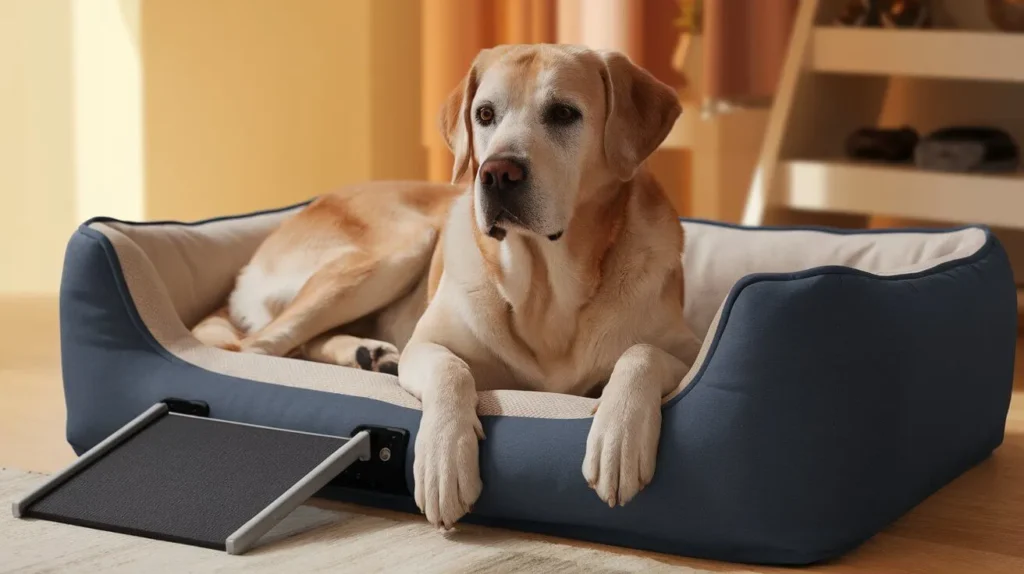How to Build a Supportive Bed for a Senior Dog with Back Problems 2025

Is your senior dog struggling with back problems, arthritis, or stiff joints? A supportive orthopedic dog bed can make all the difference in their comfort and mobility. As dogs age, they need extra cushioning and spinal alignment to relieve pain—but store-bought beds can be expensive. In this guide, you’ll learn how to build an affordable DIY orthopedic dog bed with memory foam, proper support, and a cozy design tailored for aging pets. Let’s help your furry friend sleep pain-free!
Why a Supportive Bed is Important for Senior Dogs
Older dogs suffer from:
- Arthritis – Stiff, painful joints make movement difficult.
- Hip Dysplasia – Weak hips need extra cushioning.
- Spinal Problems – Herniated discs or degenerative conditions require firm support.
- Pressure Sores – Thin padding leads to discomfort.
A well-designed bed reduces pain, improves sleep, and helps your dog stay mobile.
Materials Needed for a DIY Orthopedic Dog Bed
Here’s what you’ll need:
1. Base Materials
- Plywood or Solid Board (for structure)
- High-Density Foam (2-4 inches thick) – Memory foam or orthopedic foam works best.
- Egg Crate Foam (optional for extra cushioning)
2. Cover & Comfort Layers
- Waterproof Mattress Cover (to protect from accidents)
- Soft Fabric (fleece, cotton, or microfiber)
- Non-Slip Mat (to keep the bed in place)
3. Tools Required
- Scissors or utility knife
- Staple gun or strong adhesive
- Sewing machine (if making a custom cover)
- Measuring tape
Step-by-Step Guide to Building the Bed
Step 1: Measure Your Dog
- Have your dog lie down naturally and measure their length and width.
- Add 6-8 inches for extra comfort.
Step 2: Cut the Base
- Use plywood or a sturdy board as the foundation.
- Cut it to the measured size.
Step 3: Add the Foam Layers
- Place high-density foam on the base (2-4 inches thick).
- For extra softness, add an egg crate foam layer on top.
- Secure with adhesive or a fitted cover.
Step 4: Create a Removable Cover
- Use a waterproof liner to protect the foam.
- Sew a soft, washable cover (fleece or cotton) for comfort.
Step 5: Make It Non-Slip
- Attach a rubber mat underneath to prevent sliding.
Alternative: No-Sew DIY Dog Bed
If you don’t sew:
- Use a large pillowcase as a cover.
- Stuff it with memory foam toppers or old pillows.
- Secure with Velcro straps.
Best Store-Bought Orthopedic Dog Beds
If DIY isn’t your style, consider these options:
- Big Barker Orthopedic Bed (best for large dogs)
- BarxBuddy Memory Foam Bed (waterproof & supportive)
- PetFusion Ultimate Dog Bed (solid foam base)
Extra Tips for Senior Dog Comfort
- Elevated Beds – Good for airflow and joint relief.
- Heated Pads – Help stiff muscles (use low heat).
- Ramps & Steps – Reduce jumping strain.
What Makes a Bed Supportive for a Senior Dog with Back Problems?
- Memory Foam: This material contours to your dog’s body, providing excellent support and pressure relief. Look for high-density memory foam for the best results.
- Orthopedic Foam: Similar to memory foam but often firmer, orthopedic foam offers excellent support for joints and spines.
- Egg-Crate Foam: This textured foam can help improve air circulation and provide some cushioning, often used as a base layer.
- Appropriate Thickness: The bed should be thick enough to prevent your dog from sinking to the floor. For larger dogs or those with significant back problems, a thicker bed is generally better.
- Right Height: Consider your dog’s size and mobility. A bed that’s too high or too low can be difficult for them to get in and out of.
Conclusion
A supportive bed can greatly improve your senior dog’s comfort. Whether you build one yourself or buy a high-quality orthopedic bed, your dog will thank you for the relief it provides. Follow these steps to ensure your furry friend sleeps pain-free!
Would you like recommendations for specific dog breeds or budget-friendly options? Let us know in the comments!



